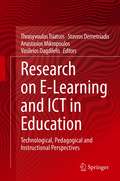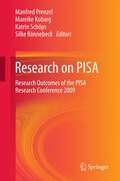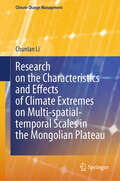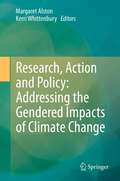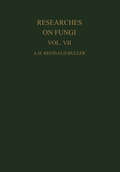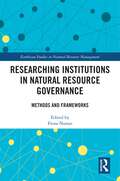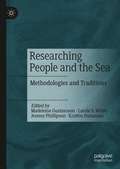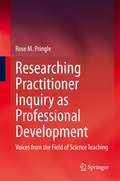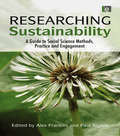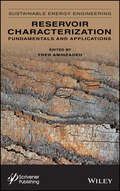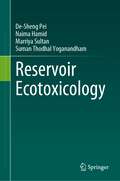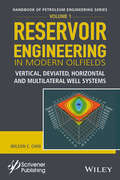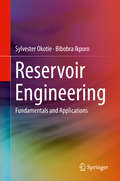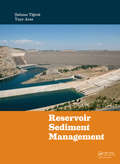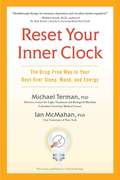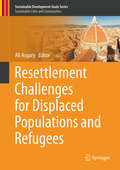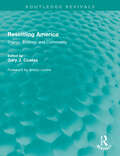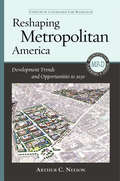- Table View
- List View
Research on E-Learning and ICT in Education: Technological, Pedagogical and Instructional Perspectives
by Thrasyvoulos Tsiatsos Stavros Demetriadis Anastasios Mikropoulos Vasileios DagdilelisThis volume includes contributions based on selected full papers presented at the 11th Pan-Hellenic and International Conference “ICT in Education”, held in Greece in 2018. The volume includes papers covering technical, pedagogical, organizational, instructional, as well as policy aspects of ICT in Education and e-Learning. Special emphasis is given to applied research relevant to the educational practice guided by the educational realities in schools, colleges, universities and informal learning organizations. This volume encompasses current trends, perspectives, and approaches determining e-Learning and ICT integration in practice, including learning and teaching, curriculum and instructional design, learning media and environments, teacher education and professional development. It is based on research work originally presented at the conference, but the call for chapters was open and disseminated to the international community attracting also international contributions.
Research on PISA
by Katrin Schöps Mareike Kobarg Manfred Prenzel Silke RönnebeckThe Programme for International Student Assessment (PISA) is an important part of the OECD's Indicator Programme. It collects data and provides comparative indicators of education systems in OECD member and partner countries. PISA provides datasets of outstanding quality regarding samples, instruments and analyses. In addition to its important function for educational monitoring, the PISA datasets are the basis of a wide range of secondary analyses from a number of different scientific perspectives and disciplines. The aim of this book is to make some of the outstanding PISA related research results available for a wider audience. Specifically four research areas will be focused: (1) Content related research; (2) Methodological research; (3) Context related research; (4) Research on trends in PISA. Each part of the book is devoted to one of these areas and will start with an introduction from a leading expert in the field followed by chapters covering research conducted in this field.
Research on Power-Frequency Fields: Completed Under the Energy Policy Act of 1992
by National Research CouncilA report on Research on Power-Frequency Fields
Research on Ship Design and Optimization Based on Simulation-Based Design (SBD) Technique
by Bao-Ji Zhang Sheng-Long ZhangShip optimization design is critical to the preliminary design of a ship. With the rapid development of computer technology, the simulation-based design (SBD) technique has been introduced into the field of ship design. Typical SBD consists of three parts: geometric reconstruction; CFD numerical simulation; and optimization. In the context of ship design, these are used to alter the shape of the ship, evaluate the objective function and to assess the hull form space respectively. As such, the SBD technique opens up new opportunities and paves the way for a new method for optimal ship design. This book discusses the problem of optimizing ship’s hulls, highlighting the key technologies of ship optimization design and presenting a series of hull-form optimization platforms. It includes several improved approaches and novel ideas with significant potential in this field
Research on Teaching Astronomy in the Planetarium
by Timothy F. Slater Coty B. TatgeFrom a noted specialist in astronomy education and outreach, this Brief provides an overview of the most influential discipline-based science education research literature now guiding contemporary astronomy teaching. In recent years, systematic studies of effective and efficient teaching strategies have provided a solid foundation for enhancing college-level students' learning in astronomy. Teaching astronomy and planetary science at the college-level was once best characterized as professor-centered, information-download lectures. Today, astronomy faculty are striving to drastically improve the learning environment by using innovative teaching approaches. Uniquely, the authors have organized this book around strands of commonly employed astronomy teaching strategies to help readers, professors, and scholars quickly access the most relevant work while, simultaneously, avoiding the highly specialized, technical vocabulary of constructivist educational pedagogies unfamiliar to most astronomy professors. For readers who are currently teaching astronomy at the college level--or those who plan on teaching at the college level in the future--this Brief provides an indispensable guide.
Research on the Characteristics and Effects of Climate Extremes on Multi-spatial-temporal Scales in the Mongolian Plateau (Climate Change Management)
by Chunlan LiCompared with average climate changes, climate extremes which are considered as low-probability events have greater impacts on natural and social systems due to their suddenness, unpredictability and strong destructiveness. Located in the typical arid–semiarid climate transition zone, the Mongolian Plateau, dominated by herbage animal husbandry, is greatly affected by climate extremes, and its ecosystem is extremely fragile. In the context of global warming, the spatial-temporal variation research about climate extremes and their impacts on vegetation is not only beneficial to the protection of the grassland ecological environment in the Mongolian Plateau, but also of great significance to formulate an effective meteorological disaster risk management.Based on daily highest temperature, daily minimum temperature and daily precipitation dataset of 111 meteorological stations over Mongolian Plateau from 1961 to 2014. Firstly, sixteen extreme temperature indices and eleven extreme precipitation indices were calculated. Then, multi-spatial-temporal characteristics of climate extremes in the scope of intensity, duration and frequency were analyzed. At the same time, the vegetation variations were analyzed based on GIMMS NDVI3g data. Thirdly, correlation analysis and multiple stepwise regression analysis were used to analyze the relationships between extreme climate indices and NDVI in different spatial scales from the perspective of single factor and multiple factors, respectively. Finally, the future change of climate extremes in duration were explored based on the climate model data. At the same time, the vulnerable areas of grassland and forest were also identified, and adaptive options of different scales were proposed.Researchers engaged in extreme climate change and managers of government departments are the readership/primary audience for the work.
Research, Action and Policy: Addressing the Gendered Impacts of Climate Change
by Kerri Whittenbury Margaret AlstonResearch, Action and Policy: Addressing the Gendered Impacts of Climate Change presents the voices of women from every continent, women who face vastly different climate events and challenges. The book heralds a new way of understanding climate change that incorporates gender justice and human rights for all.
Researches on Fungi, Vol. VII: The Sexual Process in the Uredinales
by A. H. BullerThis is the last volume of the late Professor Buller's monumental work on Fungi. Before his death in 1943, Dr. Buller had completed the manuscript; the final preparation for press has been made by Dr. G.R. Bisby of the Imperial Mycological Institute, Kew. Publication of the volume has been sponsored by the Royal Society of Canada, and the work of proofreading undertaken by Dr. W.E. Hanna, Dr. J.H. Craigie, and Dr. F.L. Drayton; the index has been prepared under Dr. Hanna's supervision. A foreword has been contributed by Dr. Joseph A. Pearce, President of the Royal Society.
Researching Institutions in Natural Resource Governance: Methods and Frameworks (Earthscan Studies in Natural Resource Management)
by Fiona NunanThis book presents an overview of different data collection methods and approaches that have been used to identify and analyse institutions associated with natural resource governance.Institutions as rules of the game are fundamental to the management, governance and use of renewable natural resources, such as fisheries, forests and water. Yet researching institutions, particularly informal institutions, can be challenging as they can be difficult to identify, investigate and understand. This volume tackles this challenge head on. The innovative collection brings together contributions from different disciplines and traditions reporting and reflecting on a range of qualitative and quantitative research methods and experiences. The book begins by reviewing definitions and typologies of institutions and introduces different approaches to researching institutions in natural resource governance, namely the Bloomington School, associated with Elinor Ostrom, and Critical Institutionalism. Following this, each chapter provides an overview and example of application of research approaches and methods, including mixed methods, institutional grammar, fuzzy cognitive mapping, network analysis, assemblage and ethnography. The concluding chapter identifies key insights into institutions and lessons on researching institutions. From these, the chapter provides a set of observations on researching institutions in natural resource governance, with the aim of providing guidance for new and experienced researchers.The volume provides an essential introduction for students and researchers into the range of methods and approaches, and their practical application, that can be used to research institutions associated with natural resource governance.
Researching Live Music: Gigs, Tours, Concerts and Festivals
by Chris AndertonResearching Live Music offers an important contribution to the emergent field of live music studies. Featuring paradigmatic case studies, this book is split into four parts, first addressing perspectives associated with production, then promotion and consumption, and finally policy. The contributors to the book draw on a range of methodological and theoretical positions to provide a critical resource that casts new light on live music processes and shows how live music events have become central to raising and discussing broader social and cultural issues. Their case studies expand our knowledge of how live music events work and extend beyond the familiar contexts of the United States and United Kingdom to include examples drawn from Argentina, Australia, France, Jamaica, Japan, New Zealand, Switzerland, and Poland. Researching Live Music is the first comprehensive review of the different ways in which live music can be studied as an interdisciplinary field, including innovative approaches to the study of historic and contemporary live music events. It represents a crucial reading for professionals, students, and researchers working in all aspects of live music.
Researching People and the Sea: Methodologies and Traditions
by Madeleine Gustavsson Carole S. White Jeremy Phillipson Kristen OunanianIn this unique edited collection, social scientists reflect upon and openly share insights gathered from researching people and the sea. Understanding how people use, relate to and interact with coastal and marine environments has never been more important, with social scientists having an increasingly vital contribution to make. Yet practical experiences in deploying social science approaches in this field are typically hidden away in field notes and unpublished doctoral manuscripts, with the opportunity for shared learning that comes from doing research often missed. There is a need for reflection on how social science knowledge is produced. This collection presents experiences from the field, its necessary reflexivity and innovation in methods, and the challenges and opportunities of translating across disciplines and policy. It brings to light the tacit expertise needed to study people and the sea and offers lessons which readers could employ in their own research. With a focus on the future direction of marine social sciences, the volume is highly relevant to masters and doctoral students and more experienced researchers engaged in studying people and the sea, as well as policy makers, practitioners and scientists wishing to understand the social dimension of marine and coastal environments. Chapters 2 and 3 are available open access under a Creative Commons Attribution 4.0 International License via link.springer.com.
Researching Practitioner Inquiry as Professional Development: Voices from the Field of Science Teaching
by Rose M. PringleThis book presents the authentic voices of science teachers engaged in practitioner inquiry as one component of a comprehensive professional development program. Practitioner inquiry as a genre of educational research, allows teachers to intentionally study their practices thus generating practical solutions to problems in their teaching and students’ learning. The teachers’ voices allowed us to enter their science classrooms to observe their posture and practices as reflective practitioners. They encountered issues such as culturally responsive teaching and low literacy proficiency and metacognitive skills among their struggling science learners. Their firsthand accounts provide new insights about practitioner inquiry as a tool to support teachers continuous learning, regardless of the disciplinary content areas. The book therefore provides a blueprint that can inform inservice teacher educators and support school and district administrators as they seek to nurture teachers’ professional growth.
Researching Sustainability: A Guide to Social Science Methods, Practice and Engagement
by Paul Blyton Alex FranklinThis book is for students and researchers across the social sciences who are planning, conducting and disseminating research on sustainability-related issues. Real-world sustainability problems cross many boundaries, and this is the first book to guide students and practitioners through the practical and theoretical challenges of doing interdisciplinary research in this vital and emerging area. Researching Sustainability contains many in-depth, 'hands on' accounts by expert contributors, providing real-life examples and lessons that can be put to use immediately. Coverage includes: the general challenges that sustainability presents to researchers, including frictions between sustainability and scientific tradition; complexity; research paradigms; interdisciplinarity; social-environmental interactions; and ethical concerns. a host of social science based research methods and approaches. Each chapter presents a different method; its challenges and suitability for different situations; an in-depth example of the method in action; insights and lessons. dissemination of sustainability research findings, including influencing policy, communicating with school children and working with the media. The book concludes with a critical synthesis of issues and methods examined in the book together with a discussion of future research pathways. This book is an essential tool for students, researchers and practitioners in planning, implementing and evaluating their sustainability research.
Researching the Sun-Earth-Moon System, Student Guide
by National Science Resources Center John Norton Amy CharlesNIMAC-sourced textbook
Reservoir Characterization: Fundamentals and Applications (Studies In Fuzziness And Soft Computing Ser. #80)
by Fred AminzadehThis second volume in the series, “Sustainable Energy Engineering,” covers reservoir characterization, a huge part of the production process and crucial to the power generation supply chain. Long though of as not being “sustainable,” newly discovered sources of petroleum and newly developed methods for petroleum extraction have made it clear that not only can the petroleum industry march toward sustainability, but it can be made “greener” and more environmentally friendly. Sustainable energy engineering is where the technical, economic, and environmental aspects of energy production intersect and affect each other. This collection of papers covers the strategic and economic implications of methods used to characterize petroleum reservoirs. Born out of the journal by the same name, formerly published by Scrivener Publishing, most of the articles in this volume have been updated, and there are some new additions, as well, to keep the engineer abreast of any updates and new methods in the industry. Truly a snapshot of the state-of-the-art, this groundbreaking volume is a must-have for any petroleum engineer working in the field, environmental engineers, petroleum engineering students, and any other engineer or scientist working with reservoirs.
Reservoir Ecotoxicology
by De-Sheng Pei Naima Hamid Marriya Sultan Suman Thodhal YoganandhamReservoir construction is the key strategy for water resource management. In recent years, the migration of pollutants and their transformation into the reservoir ecosystem has become a global problem. Intensified anthropogenic activities and unsustainable practices have amplified the pollutant levels in the reservoir. Therefore, this book intends to highlight environmental characteristics of the reservoir, study methods of ecotoxicology, and mechanistic toxicogenetic pathways of pollutants in the reservoir. Adverse outcome pathway (AOPs) model is used to elucidate toxicological effects of reservoir pollutants. Moreover, ecological and human health risks of the Three Gorges Reservoir (TGR), the largest power generation reservoir on earth, and its pollution status are also discussed.
Reservoir Engineering in Modern Oilfields: Vertical, Deviated, Horizontal and Multilateral Well Systems (Handbook of Petroleum Engineering Series #Vol. 1)
by Wilson C. ChinReal-world reservoirs are layered, heterogeneous and anisotropic, exposed to water and gas drives, faults, barriers and fractures. They are produced by systems of vertical, deviated, horizontal and multilateral wells whose locations, sizes, shapes and topologies are dictated "on the fly, at random" by petroleum engineers and drillers at well sites. Wells may be pressure or rate-constrained, with these roles re-assigned during simulation with older laterals shut-in, newer wells drilled and brought on stream, and so on. And all are subject to steady and transient production, each satisfying different physical and mathematical laws, making reservoir simulation an art difficult to master and introducing numerous barriers to entry. All of these important processes can now be simulated in any order using rapid, stable and accurate computational models developed over two decades. And what if it were further possible to sketch complicated geologies and lithologies, plus equally complex systems of general wells, layer-by-layer using Windows Notepad? And with no prior reservoir simulation experience and only passing exposure to reservoir engineering principles? Have the user press "Simulate," and literally, within minutes, produce complicated field-wide results, production forecasts, and detailed three-dimensional color pressure plots from integrated graphics algorithms? Developed over years of research, this possibility has become reality. The author, an M.I.T. trained scientist who has authored fifteen original research books, over a hundred papers and forty patents, winner of a prestigious British Petroleum Chairman's Innovation Award in reservoir engineering and a record five awards from the United States Department of Energy, has delivered just such a product, making real-time planning at the well-site simple and practical. Workflows developed from experience as a practicing reservoir engineer are incorporated into "intelligent menus" that make in-depth understanding of simulation principles and readings of user manuals unnecessary. This volume describes new technology for down-to-earth problems using numerous examples performed with our state-of-the-art simulator, one that is available separately at affordable cost and requiring only simple Intel Core i5 computers without specialized graphics boards. The new methods are rigorous, validated and well-documented and are now available for broad petroleum industry application.
Reservoir Engineering: Fundamentals and Applications
by Sylvester Okotie Bibobra IkporoThis book provides a clear and basic understanding of the concept of reservoir engineering to professionals and students in the oil and gas industry. The content contains detailed explanations of key theoretic and mathematical concepts and provides readers with the logical ability to approach the various challenges encountered in daily reservoir/field operations for effective reservoir management. Chapters are fully illustrated and contain numerous calculations involving the estimation of hydrocarbon volume in-place, current and abandonment reserves, aquifer models and properties for a particular reservoir/field, the type of energy in the system and evaluation of the strength of the aquifer if present. The book is written in oil field units with detailed solved examples and exercises to enhance practical application. It is useful as a professional reference and for students who are taking applied and advanced reservoir engineering courses in reservoir simulation, enhanced oil recovery and well test analysis.
Reservoir Sediment Management
by Sahnaz Tigrek Tuce ArasSiltation in reservoirs has become an important problem when dams are getting older and stop functioning when the sediment has accumulated to a certain extent. With proper sediment management techniques, negative effects of sediment can be avoided and reservoir life and performance can be improved.This volume deals with reservoir sedimentation, dep
Reservoir Simulation and Well Interference: Parent-Child, Multilateral Well and Fracture Interactions (Advances in Petroleum Engineering)
by Wilson C. Chin Xiaoying ZhuangCharged in the 1990s with solving some of petroleum engineering’s biggest problems that the industry deemed “unsolvable,” the authors of this innovative new volume solved those problems, not just using a well-published math model, but one optimized to run rapidly, the first time, every time. This not only provides numerical output, but production curves and color pressure plots automatically. And each in a single hour of desk time.Using their Multisim software that is featured in this volume, secondary school students at the Aldine Independent School District delivered professional quality simulations in a training program funded by some of the largest energy companies in the world. Think what you, as a professional engineer, could do in your daily work. Valuable with or without the software, this volume is the cutting-edge of reservoir engineering today, prefacing each chapter with a “trade journal summary” followed by hands-on details, allowing readers to replicate and extend results for their own applications. This volume covers Parent-Child, Multilateral Well and Fracture Flow Interactions, reservoir flow analysis, many other issues involving fluid flow, fracturing, and many other common “unsolvable” problems that engineers encounter every day. It is a must-have for every engineer’s bookshelf.
Reset Control Systems
by Antonio Barreiro Alfonso BañosReset Control Systems addresses the analysis for reset control treating both its basic form, and some useful variations of the reset action and reset condition. The issues regarding reset control - concepts and motivation; analysis tools; and the application of design methodologies to real-world examples - are given thorough coverage. The text opens with a historical perspective which moves from the seminal work of the Clegg integrator and Horowitz FORE to more recent approaches based on impulsive/hybrid control systems and explains the motivation for reset compensation. Preliminary material is also included. The focus then turns to stability analysis for systems using techniques which account for various time- and frequency-domain criteria. The final section of the book is centered on control systems design and application. The PI+CI compensator is detailed as are a proposed frequency domain approach using quantitative feedback theory and ideas for design improvement. Design examples are given.
Reset Your Inner Clock
by Michael Terman Ian McmahanAn enlightened approach to insomnia, depressed mood, fatigue, and other sleep-related problems of everyday life, harnessing the power of light therapy to reset the natural clock. Sleep problems and depressed mood often go hand in hand, forming a frustrating cycle. Michael Terman, Ph.D., has devoted his career to studying the brain functions that feed these disorders. In Reset Your Inner Clock, Terman and Ian McMahan, Ph.D., reveal the heart of his findings, a powerful program that recalibrates our internal clocks--our exquisitely designed, natural sensitivity to the timing and brightness of light exposure. These delicate mechanisms are often decimated by the modern demands of a 24/7 lifestyle. Beginning with a questionnaire that pinpoints the problem areas, Terman helps readers decipher when their natural internal night begins and ends. The treatment process can then start, incorporating the power of natural light and, when necessary, supplemental light therapy. His approach has brought relief to thousands of sleep sufferers, as well as those burdened by bipolar disorder, seasonal affective disorder, depression, sleep disorders due to around-the-clock work schedules, and other impediments to vibrant health. For the first time, his findings are now available for a general audience, sharing the essential elements of chronobiology in clear, authoritative, scientifically grounded chapters that are easy to apply to a variety of situations.
Resettlement Challenges for Displaced Populations and Refugees (Sustainable Development Goals Series)
by Ali AsgaryThe main focus of this book is to help better understand the multidimensionality and complexity of population displacement and the role that reconstruction and recovery knowledge and practice play in this regard. According to the UN Refugee Agency (UNHCR), the total number of people forcibly displaced due to wars and conflicts, disasters, and climate change worldwide, exceeded 66 million in 2016. Many of these displaced populations may never be able to go back and rebuild their houses, communities, and businesses.This text brings together recovery and reconstruction professionals, researchers, and policy makers to examine how displaced populations can rebuild their lives in new locations and recover from disasters that have impacted their livelihoods, and communities. This book provides readers with an understanding of how disaster recovery and reconstruction knowledge and practice can contribute to the recovery and reconstruction of displaced and refugee populations. This book will appeal to students, researchers, and professionals working in the field.
Resettling America: Energy, Ecology and Community (Routledge Revivals)
by Gary J. CoatesEvery movement has its bellweathers, the ideas that lead the way and rally its adherents towards a set of shared values and visions. Resettling America was one such beacon – a publication for its time and ahead of its time. Those of us doing the work of sustainability and the transformation of communities feel grateful for Gary’s early and prescient contribution that has shaped the thinking of so many around the US and beyond. Essential reading for all green warriors! Jason F. McLennan, Chief Sustainability Officer – Perkins & Will. Founder, Living Building Challenge. Originally published in 1981 and now reissued with a new Preface by Gary J. Coates, Resettling America was one of the first comprehensive, transdisciplinary books on the crisis of sustainability and the implications of that crisis for the re-design of buildings, towns, cities and regions. Through essays by Coates, which provide a theory of ecological design, and case studies written by leading authors and activists of the time, the book presents a strategic vision of how it would be possible to create a sustainable and livable society through a process of cooperative community development rooted in a radical re-visioning of nature, self and society. By providing a strategic vision, as well offering practical means for creating a sustainable society worth sustaining, Resettling America remains more relevant and inspiring than ever to those who face the ecology of crises that now surround us in the 21st Century.
Reshaping Metropolitan America
by Arhur C. NelsonNearly half the buildings that will be standing in 2030 do not exist today. That means we have a tremendous opportunity to reinvent our urban areas, making them more sustainable and livable for future generations. But for this vision to become reality, the planning community needs reliable data about emerging development trends. Arthur C. Nelson delivers that resource in Reshaping Metropolitan America, providing statistics about changes in population, jobs, housing, nonresidential space, and other key factors. Most importantly, he shows the benefits of reshaping America in ways that meet emerging market demands, and then outlines a policy agenda to do so. Reshaping Metropolitan America does not simply make predictions; it shows that Americans want better communities, what the benefits are, and how to get there.
